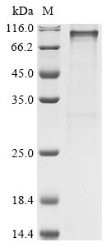Recombinant Human 2-5A-dependent ribonuclease (RNASEL) is produced in E. coli. The protein appears to be full-length, covering amino acids 1 to 741. An N-terminal GST tag has been added, which should help with purification and detection. SDS-PAGE analysis suggests the purity exceeds 85%, though this may vary between batches - still, it seems suitable for most research applications.
RNASEL plays what appears to be a crucial role in how cells defend against viruses. The protein degrades viral RNA once 2-5A oligoadenylates activate it. Beyond this antiviral function, RNASEL is likely involved in controlling RNA stability and may influence several cellular processes, including cell death and immune responses. This makes it particularly interesting for researchers studying how hosts and pathogens interact.
Potential Applications
Note: The applications listed below are based on what we know about this protein's biological functions, published research, and experience from experts in the field. However, we haven't fully tested all of these applications ourselves yet. We'd recommend running some preliminary tests first to make sure they work for your specific research goals.
Based on the provided information, the recombinant human 2-5A-dependent ribonuclease is expressed in E. coli, a prokaryotic system that is generally unsuitable for producing functional eukaryotic enzymes with complex regulation. This ribonuclease requires precise folding, activation by 2-5A oligonucleotides, and proper conformational changes for its enzymatic activity. While the protein is full-length (1-741aa) with an N-terminal GST tag and >85% purity, E. coli lacks the eukaryotic chaperones and post-translational modification machinery necessary for proper folding of this complex regulatory enzyme. The large GST tag (~26 kDa) may further interfere with the native protein structure and function. Since activity is unverified, the protein cannot be assumed to be correctly folded or bioactive without experimental validation of its 2-5A-dependent ribonuclease activity.
1. GST Pull-Down Assays for Protein-Protein Interaction Studies
The GST tag enables technical feasibility for pull-down assays. However, if the ribonuclease is misfolded (as likely in E. coli), it will not interact physiologically with true binding partners. The protein requires proper conformation for specific interactions with regulatory proteins and RNA substrates. Identified interactions could be non-physiological artifacts. This application should only be pursued after confirming proper folding and activity.
2. Antibody Development and Validation
This application is appropriate as the safest use case. The recombinant ribonuclease can serve as an effective immunogen for generating antibodies that recognize linear epitopes, even if misfolded. The full-length sequence ensures broad epitope coverage. However, antibodies may not recognize conformational or modification-dependent epitopes of native ribonuclease in human cells. Validation against endogenous protein is recommended.
3. Biochemical Characterization and Enzyme Kinetics Studies
Basic biochemical characterization (structural studies, stability) is feasible, but enzyme kinetics studies require proper folding and activity. If the recombinant ribonuclease is misfolded, kinetic parameters for 2-5A binding and ribonuclease activity will be invalid. These functional studies should only follow confirmation of 2-5A-dependent enzymatic activity.
4. Cell-Free Reconstitution Assays
This application is high-risk without activity validation. If the ribonuclease is misfolded, cell-free assays will not reflect its physiological role in interferon pathways. The GST tag allows controlled removal, but this doesn't compensate for potential folding issues. This application requires prior demonstration of proper folding and enzymatic activity.
Final Recommendation & Action Plan
Given the high probability of misfolding in E. coli for this complex eukaryotic enzyme, we recommend first validating the protein's 2-5A-dependent ribonuclease activity using known RNA substrates and activation conditions. Perform biophysical characterization (size-exclusion chromatography, circular dichroism) to assess folding state. Antibody development can proceed immediately as the lowest-risk application. Avoid all functional studies (interactions, kinetics, cell-free assays) until proper folding and enzymatic activity are confirmed. For reliable ribonuclease studies, obtain the protein from eukaryotic expression systems capable of proper folding and post-translational modifications.






